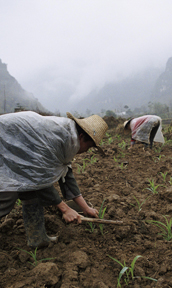Research Brief
The political economy of food price policy in China
The global food crisis in 2007–08 raised concerns everywhere, including in China. However, despite China’s highly-integrated domestic and international markets for many agricultural commodities, the effect of the crisis in China was only moderate. The government’s responses and countermeasures to the food crisis played key roles in stabilizing domestic markets. The rapid responses and effective countermeasures were largely due to China’s economic and political system.
China’s response to the food price crisis of 2007-08 was rapid, decisive, and effective
Policy response focused on stabilizing domestic food prices and ensuring national food security
China’s domestic grain price increased only moderately during the crisis
While China’s food price stabilization policies helped the country meet its food security goals by keeping domestic grain prices from rising, they may have exacerbated the world food price increase
China’s economic and political system
Five characteristics mark China’s economic and political system as unique:
- China has always considered agriculture a fundamental sector in its economy. Over the past three decades, the growth of agriculture has been the foundation for the successful transformation of China’s economy.
- China has developed an effective and competitive market system, with its agricultural markets integrated not only domestically, but also with international markets.
- The Communist Party of China (CPC) is the country’s sole political party in power. The State Council, governed by the powerful CPC, is able to respond rapidly and strongly to any short‐term crisis.
- China has invested in agricultural, rural, and regional development in an attempt to reduce its large disparities among regions, between rural and urban areas, and among households within urban or rural areas.
- Improving food security is a primary goal of China’s agricultural policy.

Initial response to the global food crisis
In the autumn of 2007, the CPC and the State Council decided to stabilize domestic food prices and ensure national food security. In making this decision, the National Development and Reform Commission, the leading group on finance and economy of the CPC, and some key government think tanks played important roles. Media reports also facilitated decision‐making by providing information and options for different stakeholders.
The countermeasures adopted at the beginning of the crisis covered a wide range of domestic and border policies. Domestic interventions began with releases of government grain stocks to increase the supply of grain in the domestic market. The government signed long‐ terms futures or forward contracts with traders in exporting countries, and it increased production and input subsidies to farmers to compensate them for the rising input prices and the growing gap between domestic and international grain prices. It provided insurance to producers to mitigate market risks, raised food price subsidies for low‐income consumers and college students in urban areas, and enhanced the social safety net and protection system.
At the same time, China adopted corresponding border policy interventions. The government suspended subsidies for storage and transport of grain for export, and it cancelled the rebate of the value‐added tax for export of major foods and chemical fertilizers. It also limited, even prohibited, exports of grains traded by the state to protect domestic food prices from international food price variations.
Biofuel production
Like many other energy‐scarce countries, China had initiated policy support for its ambitious biofuel programme in the mid‐2000s. However, concerned about the effects of biofuel production on food prices, national leaders decided to suspend any expansion of biofuels based on grain as feedstock. The global food crisis also induced China’s leaders to strengthen their commitment to agricultural development and food security. Investment in agriculture, particularly agricultural technology and water, has increased significantly in recent years and is expected to increase even further.

The relevant stakeholders showed no significant resistance to these actions, because of the nature of China’s political system, the basis of its decision-making (democratic centralism), and balanced policies that took care of the different stakeholders. There is no meaningful farmers’ organization. All ministries accept food security as the primary goal of agricultural policies. Although scholars debated how to control grain prices and manage trade‐offs between producers and consumers, the leaders made the decision to stabilize food prices and to increase subsidies to producers and low‐income consumers. A few months of limits on fertilizer exports slowed its price increase, but the chemical industry did gain from the rise in domestic fertilizer prices during the food crisis period. All stakeholders related to agriculture, including farmers and consumers, gained from China’s new commitment to investing in food and agriculture in the future.
While China’s food price stabilization policies helped the country meet its food security goals by keeping domestic grain prices from rising, they may have exacerbated the world food price increase. By levying export assessments on major grain and fertilizer, China kept agricultural commodities and inputs off world markets thereby tightening supply and contributing to higher prices. Of course, China did not act alone. According to the World Bank, 28 countries other countries levied export assessments or prohibited exports during the global food price crisis. To deal with future food price spikes, a new global governance system is needed to co-ordinate actions among major food importers and exporters in the world market.
To deal with future food price spikes, a new global governance system is needed to co-ordinate actions among major food importers and exporters in the world market
The impact of the policy response
Except for soybeans, for which prices have been fully liberalized, China’s domestic grain price increased only moderately during the crisis. After the crisis, China’s grain prices returned to their prior position in relation to international prices. Although soybean and edible oil prices increased because of the crisis, and some consumers suffered from higher prices of several commodities, most of the poor in China live in rural areas and have land. There are few truly destitute urban residents.
 Join the network
Join the network